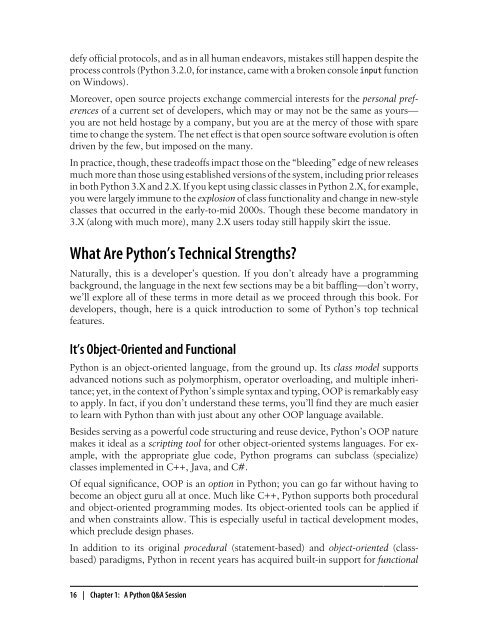Learning Python, 5th Edition - cdn.oreilly.com
Learning Python, 5th Edition - cdn.oreilly.com
Learning Python, 5th Edition - cdn.oreilly.com
Create successful ePaper yourself
Turn your PDF publications into a flip-book with our unique Google optimized e-Paper software.
defy official protocols, and as in all human endeavors, mistakes still happen despite the<br />
process controls (<strong>Python</strong> 3.2.0, for instance, came with a broken console input function<br />
on Windows).<br />
Moreover, open source projects exchange <strong>com</strong>mercial interests for the personal preferences<br />
of a current set of developers, which may or may not be the same as yours—<br />
you are not held hostage by a <strong>com</strong>pany, but you are at the mercy of those with spare<br />
time to change the system. The net effect is that open source software evolution is often<br />
driven by the few, but imposed on the many.<br />
In practice, though, these tradeoffs impact those on the “bleeding” edge of new releases<br />
much more than those using established versions of the system, including prior releases<br />
in both <strong>Python</strong> 3.X and 2.X. If you kept using classic classes in <strong>Python</strong> 2.X, for example,<br />
you were largely immune to the explosion of class functionality and change in new-style<br />
classes that occurred in the early-to-mid 2000s. Though these be<strong>com</strong>e mandatory in<br />
3.X (along with much more), many 2.X users today still happily skirt the issue.<br />
What Are <strong>Python</strong>’s Technical Strengths?<br />
Naturally, this is a developer’s question. If you don’t already have a programming<br />
background, the language in the next few sections may be a bit baffling—don’t worry,<br />
we’ll explore all of these terms in more detail as we proceed through this book. For<br />
developers, though, here is a quick introduction to some of <strong>Python</strong>’s top technical<br />
features.<br />
It’s Object-Oriented and Functional<br />
<strong>Python</strong> is an object-oriented language, from the ground up. Its class model supports<br />
advanced notions such as polymorphism, operator overloading, and multiple inheritance;<br />
yet, in the context of <strong>Python</strong>’s simple syntax and typing, OOP is remarkably easy<br />
to apply. In fact, if you don’t understand these terms, you’ll find they are much easier<br />
to learn with <strong>Python</strong> than with just about any other OOP language available.<br />
Besides serving as a powerful code structuring and reuse device, <strong>Python</strong>’s OOP nature<br />
makes it ideal as a scripting tool for other object-oriented systems languages. For example,<br />
with the appropriate glue code, <strong>Python</strong> programs can subclass (specialize)<br />
classes implemented in C++, Java, and C#.<br />
Of equal significance, OOP is an option in <strong>Python</strong>; you can go far without having to<br />
be<strong>com</strong>e an object guru all at once. Much like C++, <strong>Python</strong> supports both procedural<br />
and object-oriented programming modes. Its object-oriented tools can be applied if<br />
and when constraints allow. This is especially useful in tactical development modes,<br />
which preclude design phases.<br />
In addition to its original procedural (statement-based) and object-oriented (classbased)<br />
paradigms, <strong>Python</strong> in recent years has acquired built-in support for functional<br />
16 | Chapter 1: A <strong>Python</strong> Q&A Session
















